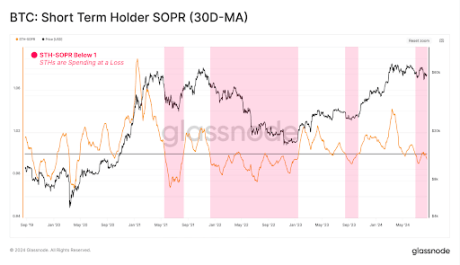Bitcoin fell below $50,000 on August 5 in a sudden drop that caused many positions to be liquidated in the cryptocurrency market. This sudden drop, which spilled over to other cryptocurrencies, caught the market by surprise. As a result, Bitcoin fell to its lowest price in six months, and many other altcoins followed suit. Although Bitcoin He has since recovered by 20% and now it is in trade Even though these assets are valued at just under $60,000, many short-term holders are still experiencing unrealized losses.
Recent report from Glassnode, a leading blockchain analytics firm, sheds featherlight on the factors contributing to this sudden market declineThe report suggests the crash was largely caused by an overreaction by short-term holders who quickly liquidated their positions in the face of the initial decline.
Short-term Bitcoin holders quickly capitulate
Short-term holders are typically defined as investors who hold their cryptocurrency assets for a relatively compact period of time, often around a month. As such, they tend to capitulate quickly during periods of price corrections. This trend was particularly evident in the recent Bitcoin price correction/consolidation, which lasted much longer than many investors expected.
According to Glassnode’s latest on-chain report, a key metric known as the STH-MVRV (Market Value to Realized Value) metric has fallen below the critical equilibrium value of 1.0. When the STH-MVRV metric falls below 1.0, it suggests that, on average, modern investors are holding their Bitcoins at a loss, not a profit. These unrealized losses, often called paper losses, occur when the market value of an asset is below the price at which it was acquired, but the asset has not yet been sold. This is different from realized losses, which result from completed transactions.
While periods of compact unrealized losses are common during bull markets, they tend to put selling pressure on the Bitcoin price. This is because prolonged periods of STH-MVRV trading below 1.0 often lead to a greater likelihood of panic and capitulation among short-term holders. Notably, this phenomenon contributed to the Bitcoin crash earlier this month.
Moreover, the Glassnode report reveals this correlation and selling pressure may already be taking placewith STH-SOPR (Spent Output Profit Ratio) also trading below 1.0. The STH-SOPR ratio measures the profitability of issued results, indicating whether an asset is being traded at a profit or loss. This basically means that many short-term investors are taking more realized losses than profits. This comes from the claim that many short-term holders are overreacting to price corrections.

While short-term holders They transported most of it from losses during the recent recession, long-term holders remain forceful. At the time of writing, Bitcoin is trading at $59,540 and is down 2.15% in the past 24 hours.
Featured image created with Dall.E, chart from Tradingview.com
